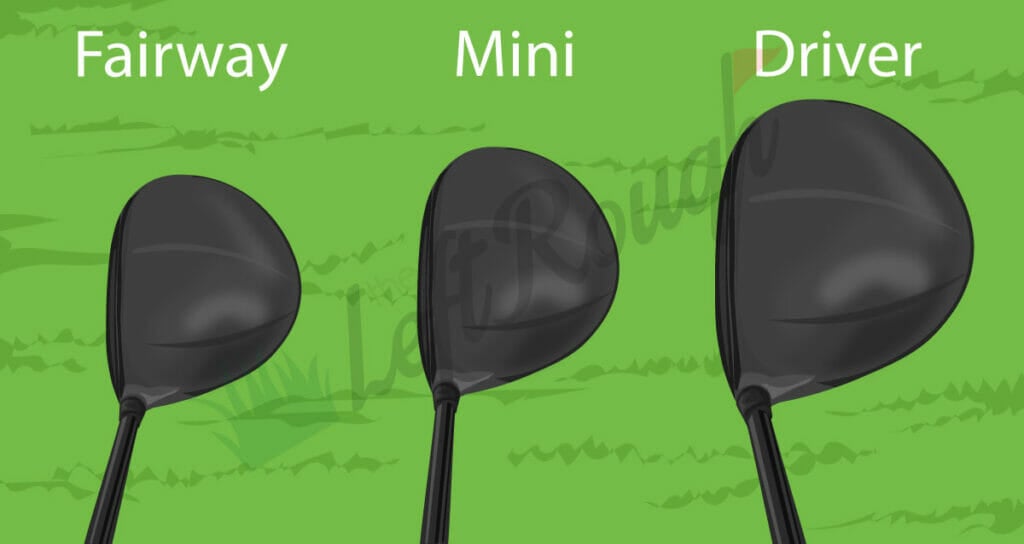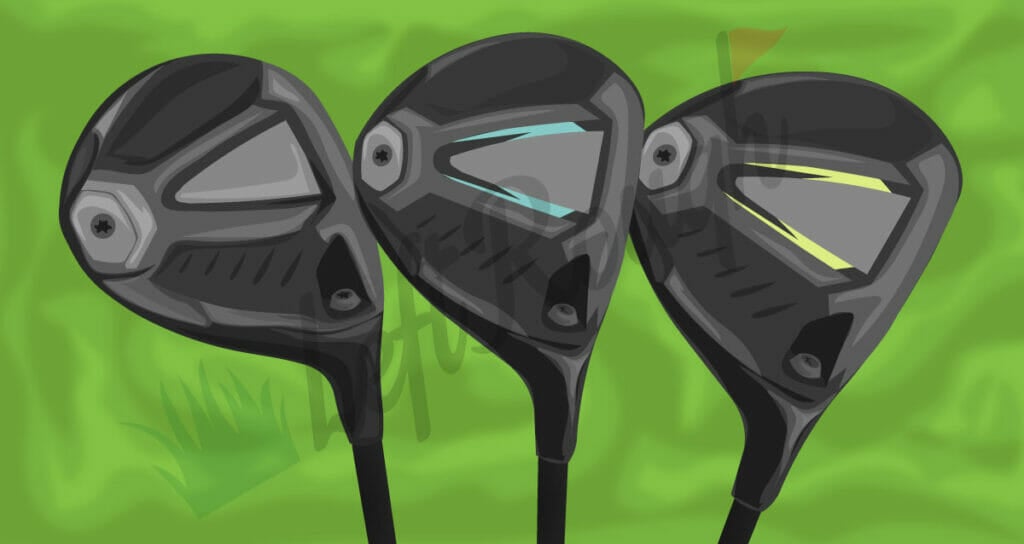[ad_1]
Did you know there are multiple types of 3-woods? Some are great for high handicappers, while others are better for a skilled golfer.
Here’s the thing, most golfers don’t consider their equipment choices enough and it can have a huge impact on your performance. If you want to play your best golf, you need the right 3-wood (and other fairway woods or hybrids).
Today, we’ll outline the main types of a 3-woods, an alternative to this popular club, and answer your biggest questions.
Types of 3-Woods
My guess is that 90% (or more) of all golfers carry a 3-wood.
Which makes sense – it’s a good alternative to driver on some holes and can help with a variety of shots on the course. It’s a great club for short par 4s, ones with narrow fairways, and can even be used around the green for chip shots.
But for full shots, some golfers struggle hitting this club from the fairway. This might be a loft issue, as lofts can vary greatly in 3-woods (between 13.5 to 17 degrees). A 3-wood is also the second-longest club in the bag, right around 43 inches for male golfers.
Keep reading to learn more about each type of 3-wood loft to see which will suit your game the best.
Key Takeaways
- A 3-wood can be a weapon on the golf course, but you need to play the right type of fairway wood.
- There are three types of three woods; a strong 3 (14 degrees of loft), standard (15 degrees of loft), and high loft (16.5 degrees).
- Playing the right design for your 3-wood to match your skill level can also help improve consistency.
- A mini-driver is an alternative pick to a conventional 3-wood, as it has the benefits of a driver and 3-wood without many downsides.
The first type of 3-wood is known as a “strong” 3-wood. This is because it has the least amount of loft – between 13.5 to 14 degrees.
These clubs are ideal for elite golfers who want to minimize spin and favor a lower trajectory. They’re also great to use off the tee as a sort of “fairway finder” as they’ll go slightly longer than higher lofted woods.
However, they’re not recommended for most everyday golfers, as the less loft makes it much harder to get a clean strike on the ball. These clubs require a perfect lie and solid mechanics to hit them well from the fairway (and not recommended in the rough).
The second type of 3-wood is a standard loft and the most common type. These clubs have 15-degrees of loft and are easier to hit from the fairway than a strong 3-wood. These 3-woods are very versatile and ideal to hit from the tee box, fairway, and light rough.
The final type of 3-wood is one that has more loft – known as HL (high loft). This club has 1–2 degrees more loft than a standard 3-wood, typically 16.5 degrees. These clubs are much easier to hit from the fairway and light rough.
Luckily, most fairway woods have adjustable hosel sleeves as well. This lets you add or remove loft to fit your ideal shot shape and trajectory.
3-Wood vs. 5-Wood
Should you carry a 3-wood and 5-wood? Or, a 3-wood and 7-wood instead?
It depends on the player, but you want to make sure your longer clubs are spaced out properly. Sometimes it’s not beneficial to have a 3-wood and 5-wood, as they’re similar in terms of loft and might travel similar distances.
A 5-wood is also shorter and easier to control. Not to mention a lot easier to hit from tight lies.
Learn more about the 3 wood vs. 5-wood debate here.
Alternate Pick: Mini Driver
The final choice isn’t a 3-wood but a mini-driver.
This club is more like a 2-wood and shares a lot of similarities to a 3-wood and driver. TaylorMade is the only company making this type of club, but it’s become extremely popular in the golf world.
A mini driver is shorter than a driver and closer to a 3-wood length…making it easier to control. It also has more loft than most drivers, as it’s available in 11.5 or 13.5 degrees. Extra loft makes it easier to control as well.

Plus, the clubhead is significantly smaller than a driver but bigger than a 3-wood. This makes it much easier to hit from the deck, which is one of the hardest shots in golf (even for professional golfers).
Additionally, this club does have extreme adjustability to fine tune it to your swing. It has a four degree loft sleeve to tweak the loft up or down and two adjustable weights. If you change the weight positioning, this can make it lower spinning, which is ideal for faster swinging golfers.
Learn more about the mini driver here.
Choosing the Right Fairway Woods
Now that we’ve covered the main types of woods, don’t forget to consider a few things.
First, is the right type of clubhead. For example, Titleist has three fairway woods in their product lineup – the TSR1, TSR2, and TSR3. Each one is designed for a certain type of player.
The TSR1 is the biggest clubhead and built for forgiveness and distance, which is needed for beginners. The TSR2 is a little smaller and built for more playability and control, with some forgiveness – making it perfect for mid-handicappers. While the TSR3 is the smallest option and made for playability for lower handicap golfers who don’t need as much forgiveness.
The second thing to consider is the shaft in your fairway woods. Just like your driver, using the right shaft can also impact distance and accuracy with your fairway woods. Test out different ones at a golf store and/or do a custom fitting if necessary to find the right weight, launch, and flex.
The third aspect to consider is if the club is adjustable or not. Most modern fairway woods allow you to tweak to your ideal swing preferences.
Others are not to make them lighter and easier to swing faster. Plus, some have built in draw bias features to help fight a slice and hit it straighter.
Lastly, make sure your fairway woods, hybrids, and irons are spaced out properly. You don’t want to have a big gap between your clubs, as it’ll leave some awkward distances on the course. Try to space clubs out 3–5 degrees apart to manage your game better.

FAQs About Fairway Woods
Do you have more questions about fairway woods? If so, keep reading through the most commonly asked questions and answers now.
How do I choose the right 3-wood?
It all depends on the type of golfer. Lower handicap golfers will benefit from 14-15 degree 3-woods with stiffer shafts and smaller clubheads.
Mid-handicap golfers will benefit most from 15-16.5 degree heads with regular or stiff flex shafts (based on swing speed). They’ll also want to find a clubhead that has a good mix of forgiveness and playability.
While high handicap golfers will benefit most from having more loft with a HL 3-wood with 16.5 degrees of loft. Paired with a lighter shaft, this will make it a lot easier to hit from the fairway or off a tee.
How many fairway woods are there?
The most common fairway woods are 3 and 5-woods. However, a 7-wood is another popular option even among professional golfers. Other fairway woods include a 9-wood, 11-wood, and Heavenwood.
What is the easiest fairway 3-wood to hit?
It’s very specific to the player’s skill and swing speed. Check out the best fairway woods for beginners here.
What iron replaces a 3-wood?
The only iron that might replace a 3-wood is a one iron, which isn’t a common club anymore in the golf world. While they were popular in the past, most golfers prefer fairway woods as they’re a lot easier to hit.
However, if you do like hitting irons instead of 3-woods, there are some good utility irons with 1-iron lofts (usually 16 degrees). Check out the Titleist driving iron or the Mizuno Pro-Fli Hi.

What is the difference between a 3-wood and 5-wood?
A 3-wood has 2–4 degrees less loft and has a longer shaft.
Due to these design differences, a 3-wood will go longer and at a lower trajectory than a 5-wood. However, a 5-wood is easier to hit consistently well and off tight lies thanks to the shorter shaft and additional loft.
My Experience
Equipment is everything in golf and I’ve made tons of mistakes when it comes to fairway woods. The biggest mistake I made was playing a 3-wood with a shaft that was too heavy. I used an 80-gram shaft (I swing the driver about 110 mph) but it didn’t benefit my game.
After switching to a lighter 70-gram shaft, I saw a noticeable difference. This is why it’s a good idea to do a custom fitting to find the right shaft. Because even if you have the right clubhead, the wrong shaft can mess it up.
Another error I made was playing a 3-wood with too little loft. This made it hard to hit off the deck and didn’t instill a ton of confidence on long par 5s. Remember, loft is your friend!
Final Thoughts
Choosing the right 3-wood and other fairway woods or hybrids can make a big difference in your long game.
If you’re struggling with a 3-wood now, consider a high lofted option or adjusting the loft of your current club. Or, you could choose to hit 5-wood from the fairway and save 3-wood for when it’s teed up to make it easier.
Also, don’t forget to check out our guide to make your 3-wood a weapon now. Or, check out the best fairway woods in golf.
Do you like hitting 3-wood? Let us know in the comments below.
[ad_2]
Source link




0 Comments